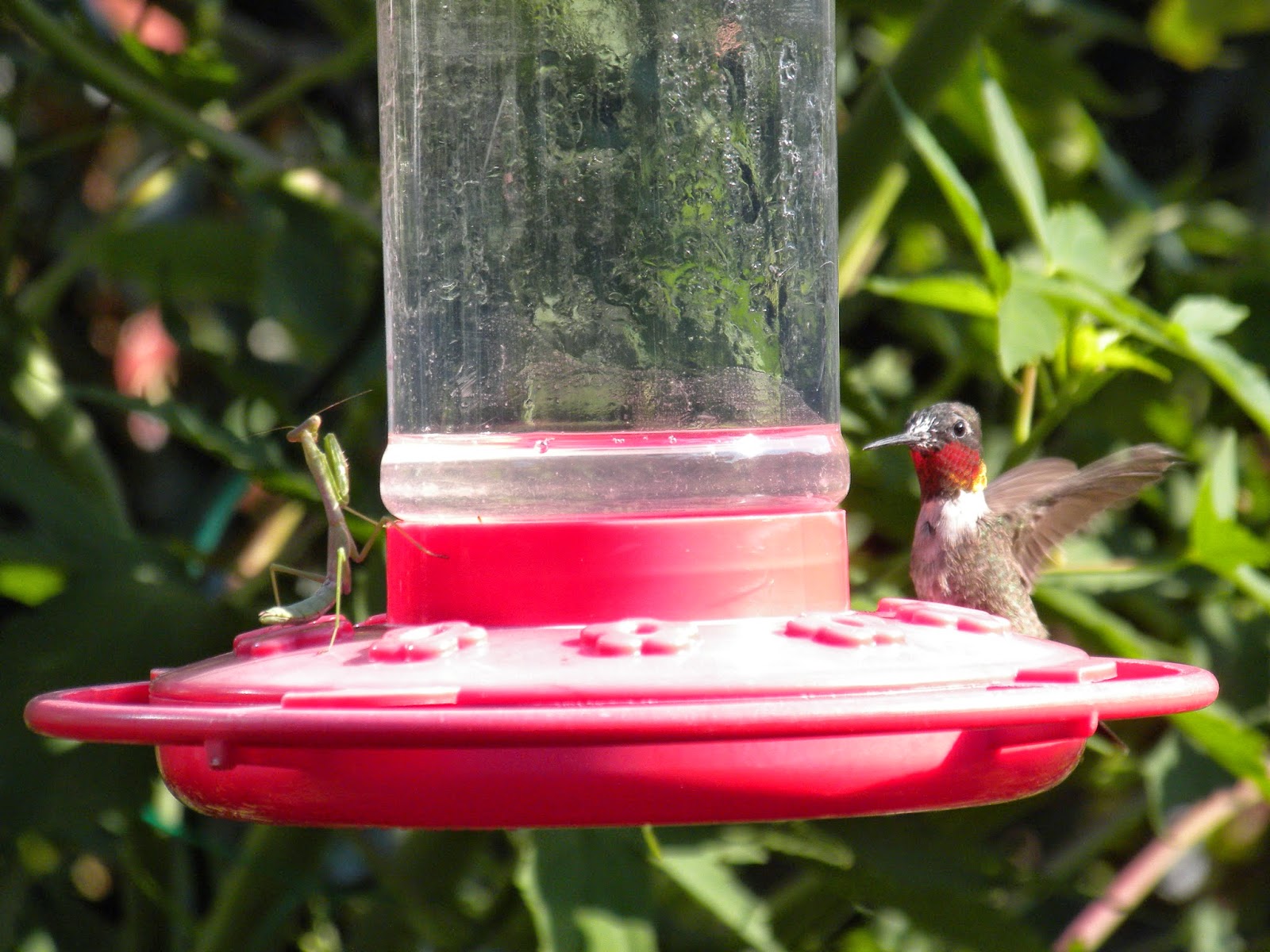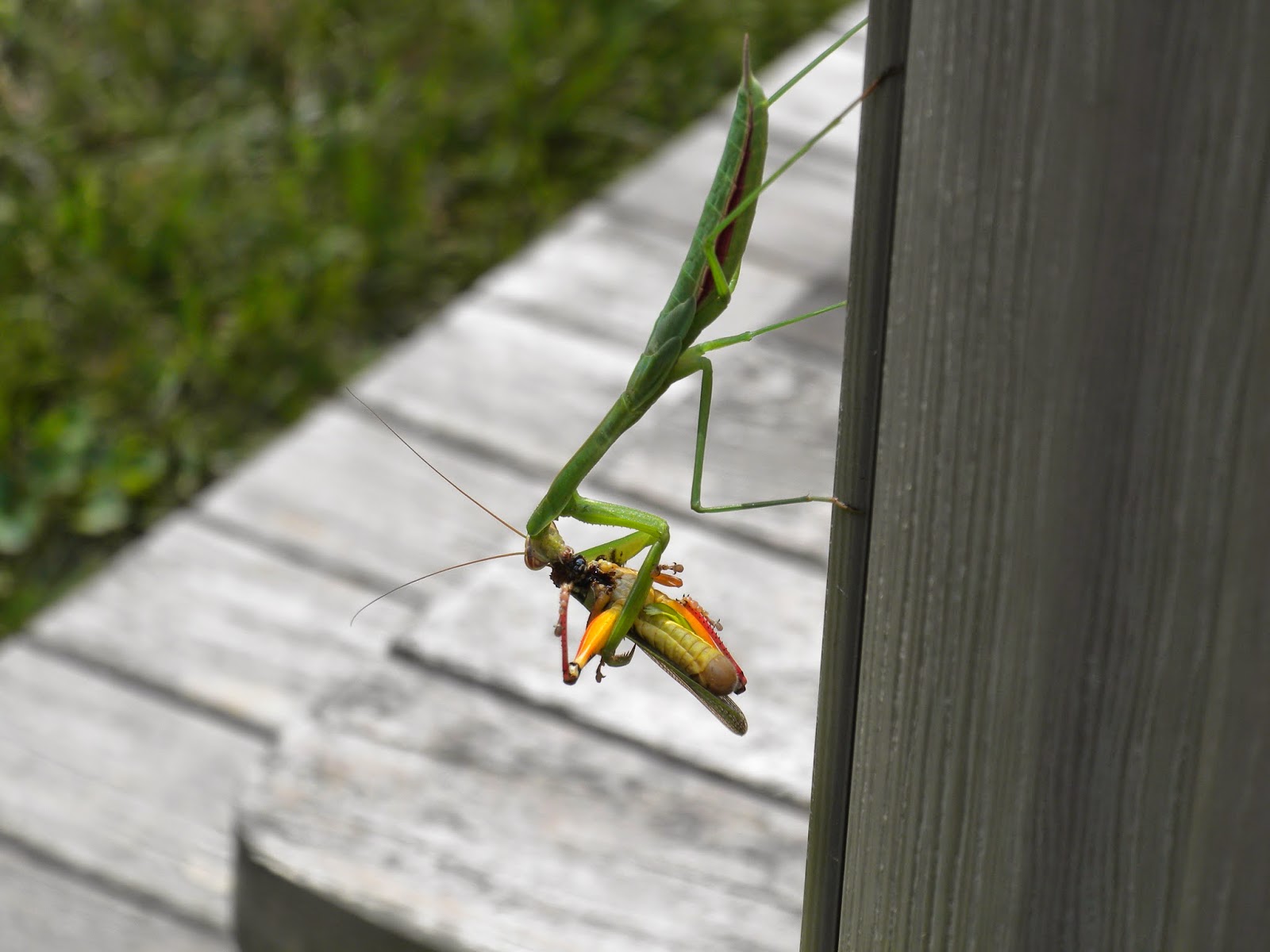It's that time of year again here in the eastern part of the US.....the hummingbirds are migrating to our backyards. Perhaps you've already spotted them in your neighborhood, but it's usually mid to late April before they're seen here in West Virginia. The hummingbirds are my favorite fair weather visitors, the only birds I feed in warmer months. I also try to plant flowers and bushes that I know hummingbirds love, such as pentas, bee balm, butterfly bushes and hibiscus. Did you know one of the hummingbirds' worst enemies is the praying mantis? It's true.
When I snapped these photos in my garden three years ago, I thought the sight was 'cute', but it's not!!
The fact is that praying mantis will patiently wait, as in the case of these photos, for the opportunity to snatch and devour an unsuspecting hummingbird. No birds were harmed in this scenario, and I am now much more knowledgeable on the subject. Nowadays, I would shoo the praying mantis, instead of trying to make a photo opportunity of the situation.
I posted the top photo of mine on my Pinterest Garden board in 2012, on my Hometalk page in 2013 and, to date, the latter has received over 51,000 views, along with many comments. It seems many folks were/are unconvinced of the predatory capabilities of the praying mantis, but there is definitely documented video evidence out there of the natural process if you want to research it.
When I snapped these photos in my garden three years ago, I thought the sight was 'cute', but it's not!!
The fact is that praying mantis will patiently wait, as in the case of these photos, for the opportunity to snatch and devour an unsuspecting hummingbird. No birds were harmed in this scenario, and I am now much more knowledgeable on the subject. Nowadays, I would shoo the praying mantis, instead of trying to make a photo opportunity of the situation.
I posted the top photo of mine on my Pinterest Garden board in 2012, on my Hometalk page in 2013 and, to date, the latter has received over 51,000 views, along with many comments. It seems many folks were/are unconvinced of the predatory capabilities of the praying mantis, but there is definitely documented video evidence out there of the natural process if you want to research it.
While praying mantis can be a beneficial insect against moths, mosquitoes, aphids and flies in the garden, please be watchful of them around your hummingbird feeders!
Each year in my garden, it seems I end up hosting a family of praying mantis in my containers, typically in my courtyard, which usually have pentas planted in them. Hummingbirds love penta flowers, so I suppose nature has its way in that praying mantis take up residence there, waiting for their opportunity. Praying mantis have a natural ability to camouflage themselves in the plantings, so it's not always easy to spot them. I typically only spot them as I'm watering containers, and they jump out after I've unknowingly sprayed them.
So, as you're readying your feeders for those sweet little hummingbirds this year, I hope you'll take heed and shoo the praying mantis from the hummingbirds. It wouldn't be fair to feed the hummers and trap them simultaneously. Besides, there are plenty of insects in the garden for the praying mantis to feast on.
Below is a quick and easy recipe for feeding your hummingbirds. I typically buy a gallon jug of water to start the season. There's no need to buy the pre-made stuff, nor is there a need to add red food coloring to the homemade feed.
Hummingbird Feed Recipe:
1 gal water
4 cups white sugar (the ratio is 1 cup sugar to 4 cups water (or 32 oz)
Place water and sugar in a large boiling pot (at least 6 qt size). Heat water to boil or near boiling, continuously stirring the sugar until dissolved. Be careful, as the sugar will stick easily to bottom of pan if not attended.
After sugar is completely dissolved, turn off heat and let cool on stove (about 45 min). Fill feeders(s). Return unused feed water to seal-tight jug (I re-use the water jug initially purchased). Feed can be stored in fridge for up to 3-5 days. Be sure to label your jug as "HUMMINGBIRD FEED - DO NOT DRINK!" so no one in your household will mistake the jug for drinking water.
When refilling feeders, be sure to clean them first. Mold can grow easily on the feeders' spouts, especially during hot, sunny days. If your feed gets cloudy, change it. I keep an old toothbrush on hand for cleaning the spouts on my feeders, and wash them with water and a drop of liquid dish soap like Dawn® if necessary (be sure to rinse well).
Here's another great tip for taking care of the hummingbird feeders: keep those pesky ants off the feeder with the Perky Pet Brand ant guard. It is, hands down, the best remedy I have found, and I have tried several other remedies including vaseline and vegetable oil wiped on the pole.
As you can see in the photo above, the ant guard easily slips onto an S hook, which is slipped onto the end of your shepherd's hook in your garden. Then, the hummingbird feeder will slip right onto the ant guard. I buy one for each feeder at the start of the season, and they last all summer long.
I have yet to spot a hummingbird nest in my yard, which would be my own personal hummingbird garden nirvana. I have only seen photos of their nests, and they are about the size of a quarter, as seen in this link: www.rubythroat.org. It is said the best way to detect the nest is to let the female direct you to it, but the nest can be nearly a mile away from the food sources. Can you imagine the energy these little creatures expend on a daily basis? They never cease to inspire and amaze me, given their size. I don't get flocks of them as some folks do, where they all feed harmoniously together. It seems the 'city' hummers I have like to dive bomb at each other, keeping one from another on each feeder very jealously (even though I have four feeders plus plantings throughout my garden). Sometimes it sounds like mini airplanes buzzing by, as their wings dart from feeder to feeder. Take a listen to the hummer's wings at this link to the Cornell Lab of Ornithology's audio of the ruby-throated hummingbird and you'll see what I mean by the sound of mini airplanes.
Do you spot hummingbirds in your area? Do you work to attract hummingbirds? How successful have you been in doing so? Did you know the praying mantis is its predator? I'd love to hear from you on this subject. In the meantime, here's a link to a great article from Birds and Blooms that identifies nectar flowers you can plant in your garden to naturally attract these welcome backyard visitors. Enjoy!
I link and party with any given
number of these fine hosts:







No comments:
Post a Comment